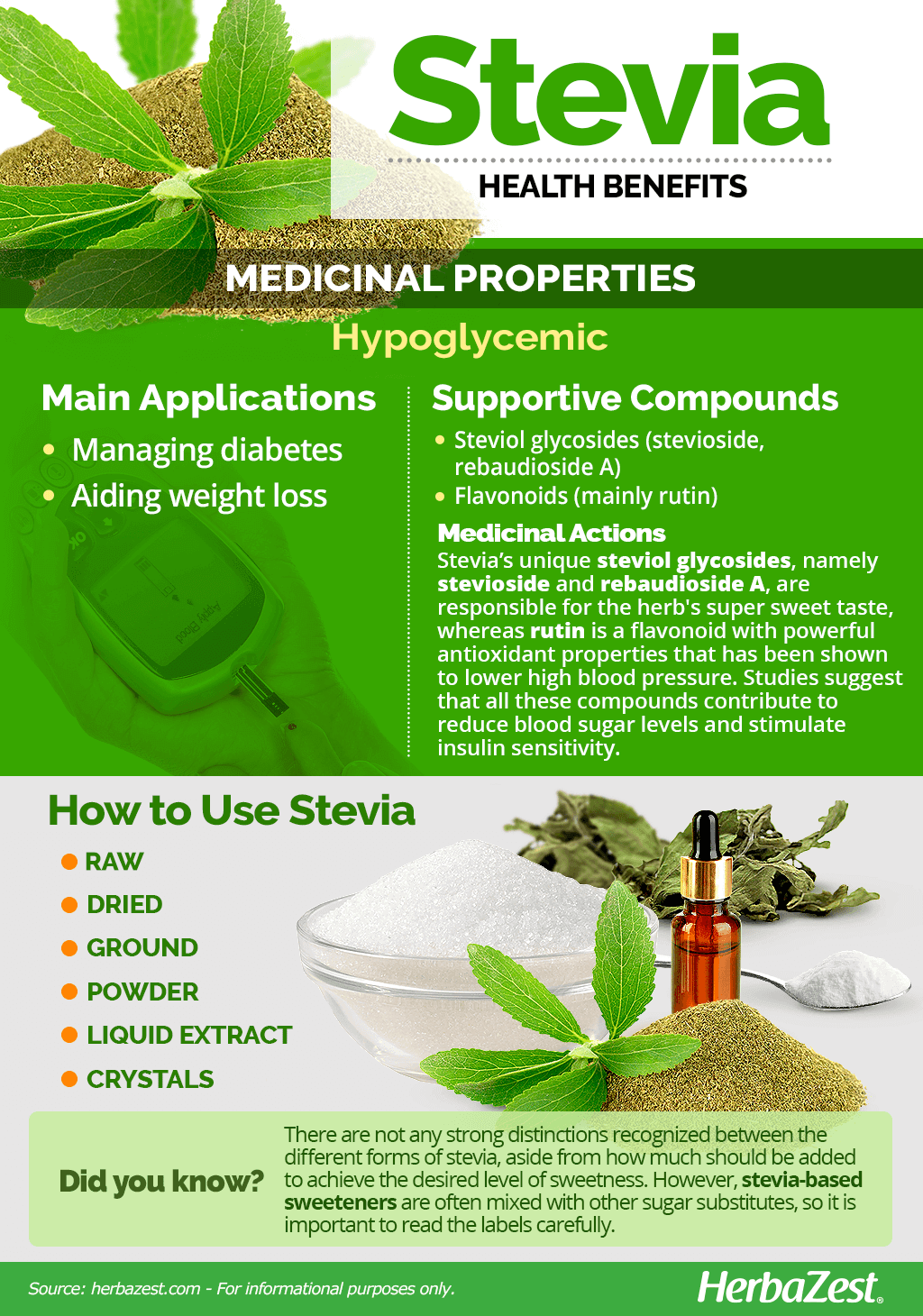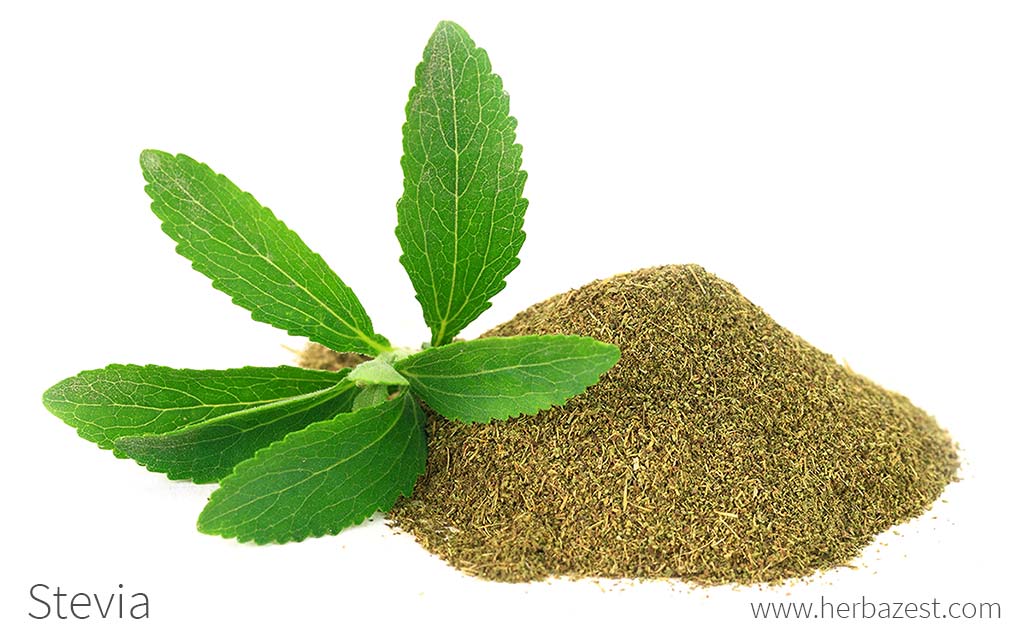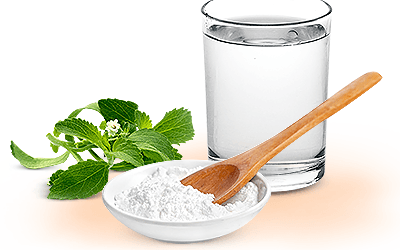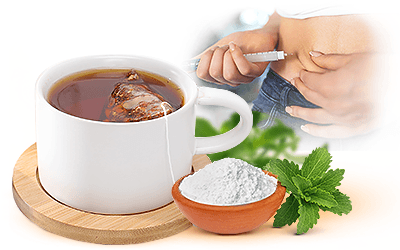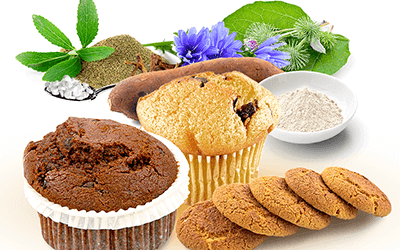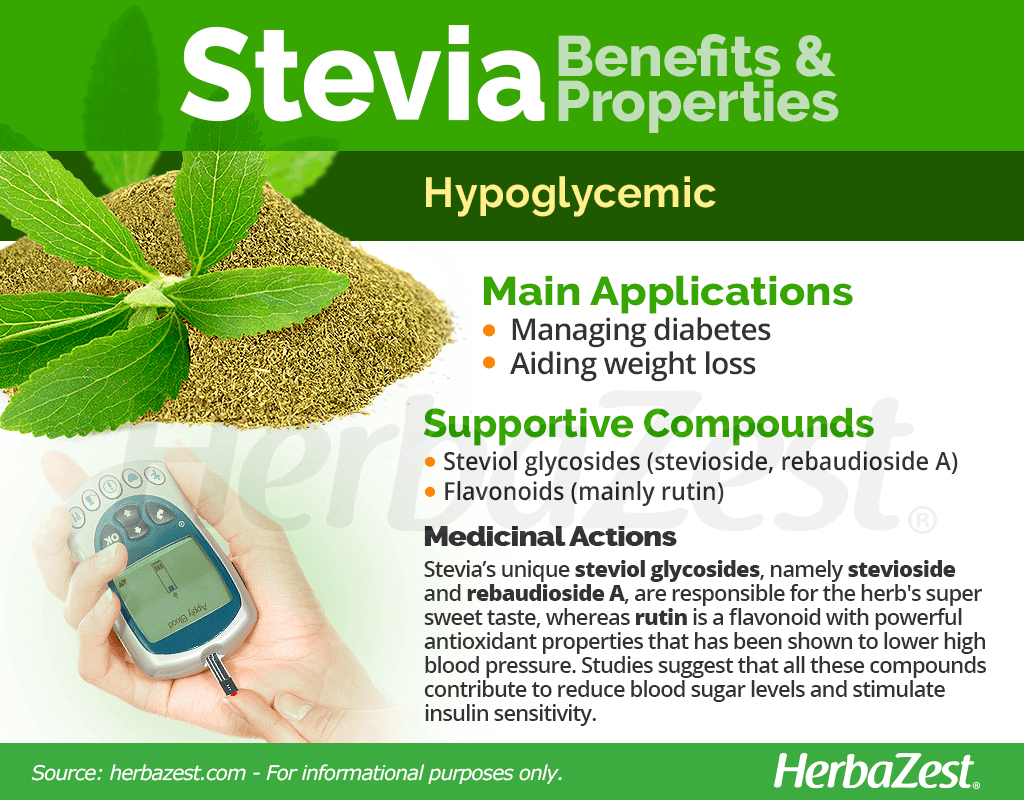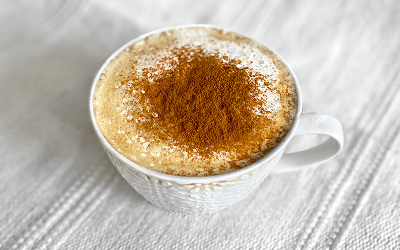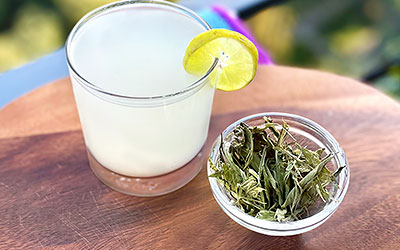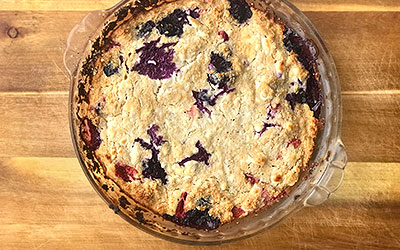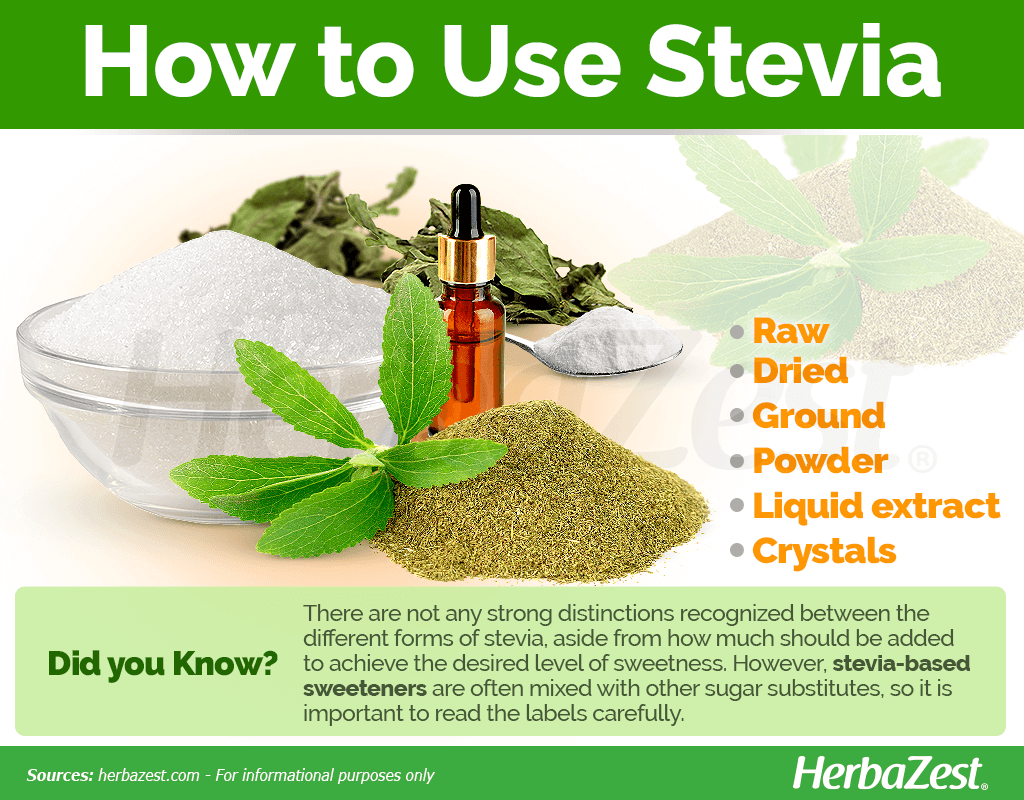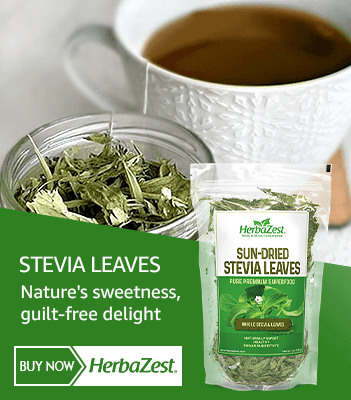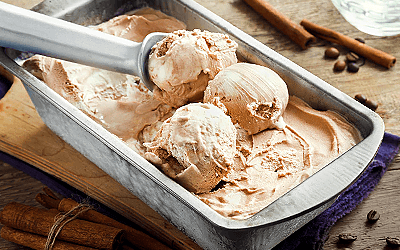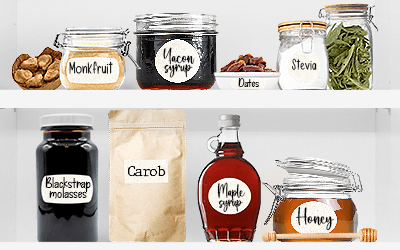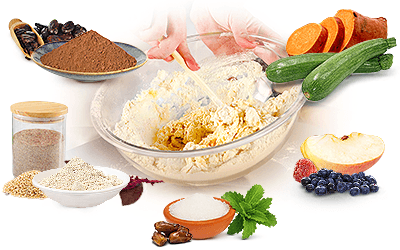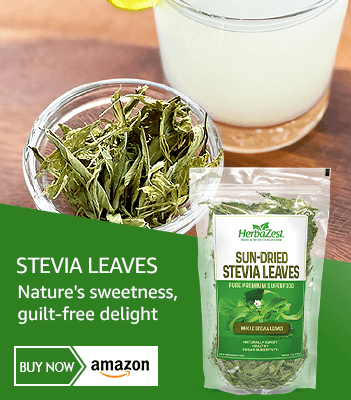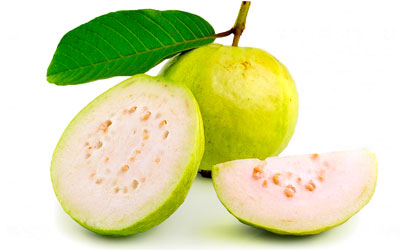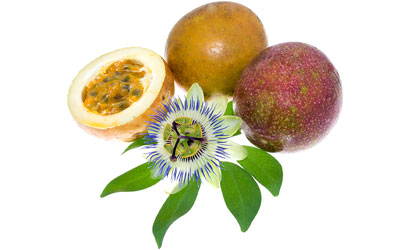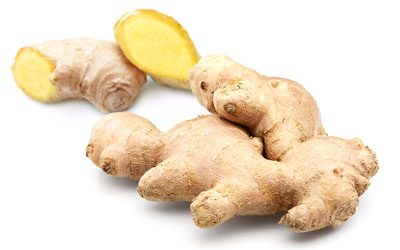Stevia is native to Brazil and Paraguay, where it has been used for hundreds of years to sweeten traditional teas, like mate, as well as medicines. Scientists today continue to conduct studies into the properties and safety of stevia, and many countries have begun approving its use as a natural sweetener.
Stevia Medicinal Properties
Health Benefits of Stevia
Stevia, while more widely used as an addition to food than a remedy on its own, has several potential health benefits, namely because it can be used as a low-calorie, low-carbohydrate alternative to sweeten meals. This means it can help with:
Managing diabetes. Research has found that stevia does not affect blood sugar levels or insulin response the same way sugar does. As such, stevia is a healthier option for diabetics than sugar or artificial sweeteners.1
Aiding weight loss. Using stevia to sweeten foods helps cut down on sugar intake, thus aiding weight management. Also, a study has shown that drinking water sweetened with stevia before a meal helps lower appetite and overall energy intake.2
Additionally, stevia has proven effective in promoting oral health by blocking the accumulation of plaque and bacteria in the mouth, which prevents tooth decay, as well as periodontitis and gingivitis.
With the rising popularity of stevia around the world, more research studies are being conducted to further evaluate stevia's potential medicinal effects, such as its effect on blood pressure.3
How It Works
Interest in stevia stems from its unique steviol glycosides, namely stevioside and rebaudioside A, both of which are responsible for the herb's super sweet taste, about 250 - 450 times sweeter than sucrose, or table sugar, but have zero-calories.
Despite the ongoing controversy regarding the medicinal uses of stevia, studies have shown that its compounds not only contribute to reduce blood sugar levels, but also stimulate insulin sensitivity, thus helping to improve the symptoms of hyperglycemia and diabetes.
Additionally, fresh, raw stevia leaves also contain vitamins A and C (ascorbic acid), minerals such as zinc, magnesium, and iron, and a flavonoid called rutin, a powerful antioxidant that has been shown to lower high blood pressure by increasing the activity of glutathione peroxidase (an antioxidant enzyme) and nitric oxide in the endothelial cells, which leads to a reduced vascular tension and improves blood flow. High levels of rutin can also be found in tea plant, noni, apples, and figs.
Stevioside is 250 - 300 times sweeter than sucrose but with a slightly bitter aftertaste, while rebaudioside A is 350 - 450 times sweeter than sucrose without any aftertaste.
Other herbs with hypoglycemic properties are bilberry, cinnamon, cow's foot, lucuma, and yacon.
Stevia Side Effects
The controversy over the possible benefits and side effects of stevia stems from the fact that many studies on this plant are in their preliminary stages. The various sweet compounds in stevia are still being researched to ascertain their long-term level of toxicity.
Those with an allergy to ragweed and other Asteraceae species may also experience a reaction to stevia.
Cautions
Stevia can affect how the body processes lithium. Those taking lithium should avoid stevia use. As stevia can affect blood sugar and blood pressure, it should not be consumed alongside medications or supplements that affect these two factors.
- Medicinal action Hypoglycemic
- Key constituents Steviol glycosides (stevioside, rebaudioside A), flavonoids (mainly rutin)
- Ways to use Hot infusions/tisanes, Liquid extracts, Powder, Dried
- Medicinal rating (1) Very minor uses
- Safety ranking Safe
How to Consume Stevia
Stevia has not known culinary applications beyond it use as a healthier substitute for sugar, and can be found both in its natural state (fresh or dried) and in a variety of supplements.
Natural Forms
Raw. The fresh leaves of stevia can be used as a natural sweetener for hot and cold beverages.
Dried. In their dried form, stevia leaves have a longer shelf life and can be used in infusions.
Ground. The dried leaves of stevia are often finely ground and used directly, as a natural sugar substitute, in beverages and baked goods. This pure stevia powder is green in color.
Herbal Remedies & Supplements
Liquid extract. This is a popular form of consuming stevia, since it lacks the slightly bitter aftertaste of natural forms.
Powder. The active compound of stevia, rebaudioside A, is chemically extracted in order to obtain a sweet powder.
Crystals. Stevia crystals look like sugar cubes and are used in the same way, but without any caloric content.
There are not any strong distinctions recognized between the different forms of stevia, aside from how much should be added to achieve the desired level of sweetness.
- Edible parts Leaves
- Edible uses Sweetener
- Taste Sweet
Growing
Stevia is small shrub from the tropical forests of South America, and some basic conditions need to be considered in order to succeed in its home cultivation.
Growing Guidelines
Stevia should be grown in well-drained garden beds, though it will also adapt well to a large container.
This plant grows better in neutral soil, with an ideal pH of 6.7 - 7.2.
It grows best in warm conditions, similar to those of its natural tropical and subtropical habitat.
Stevia needs to be regularly pruned to return optimum results.
The stevia plants should be planted about two feet (60 cm) apart from each other after the last frost in an area that gets full sun.
Three to five plants will grow a year's supply of leaves, which can be plucked and dried.
More detailed information about growing stevia can be found in the herb garden section.
- Life cycle Perennial
- Harvested parts Leaves
- Light requirements Full sun
- Soil pH 6.6 – 7.3 (Neutral)
- Growing habitat Subtropical regions
- Planting time Right after last frost
Additional Information
Plant Biology
Native to South America, particularly Brazil and Paraguay, the stevia plant grows to between 26 - 32 inches (65 - 80 cm) tall, in semi-dry mountainous environments, and is covered with fine, short, white hair. It bears white, cone-shaped flowers with long stamens. The green parts of the plant provide its valued sweet taste.
Classification
Stevia is a member of the Asteraceae (Compositae) family, commonly known as the aster, daisy, or sunflower family. This family contains 23,000 species spread out over 1,620 genera, including economically important crops, such as artichoke (Cynara cardunculus) and lettuce (Lactuca Sativa), as well as medicinal herbs like milk thistle (Silybum marianum), chicory (Cichorium intybus), and chamomile (Matricaria chamomilla).
The Stevia genus contains 240 species of herbs and shrubs, being Stevia rebaudiana the most economically-important.
Varieties and Cultivars of Stevia
Although there are many different species of the genus Stevia, S. rebaudiana is the only one that possesses the natural sweetness for which it is valued. To date, no subspecies or other varieties have been identified in the wild. However, Japanese food and confectionery companies have developed the 'Rebaudio' cultivar for use in their products.
Historical Information
Stevia has been an important herb in certain South American cultures for over a millennium, and its consumption by the Guaraní people, in Paraguay, can be traced as far back as 1,500 years ago.
In 1899, Swiss botanist Moisés Santiago Bertoni began conducting research into stevia while in Paraguay, becoming the first Westerner to describe it in detail. However, research remained limited until the 20th century, when there was a more thorough investigation into its sweet properties.
Economic Data
Stevia has grown into an economically-important product since it began being used as a sugar substitute. In 1971, it was first commercialized as a sweetener, and since then, many large firms have begun using it in their products, which has encouraged different countries to invest in its commercial cultivation. Currently, China is the largest exporter of stevia, and the plant is continuing to grow in popularity.
Other Uses
Some manufacturers have begun adding stevia to toothpaste to improve its taste. Aside from this, though, stevia is used almost exclusively as a food and beverage additive or for supplements.
Sources
- American Journal of Analytical Chemistry, Determination of Rebaudioside A and Stevioside in Leaves of S. rebaudiana Bertoni Grown in México by a Validated HPLC Method, 2015
- Appetite, Effects of stevia, aspartame, and sucrose on food intake, satiety, and postprandial glucose and insulin levels, 2010
- European Commission, Scientific Committee on Food
- International Journal of Food Sciences and Nutrition, Stevia (Stevia rebaudiana) a bio-sweetener: a review, 2010
- Journal of Pharmacology & Pharmacotherapeutics, Sugar substitutes: Health controversy over perceived benefits, 2011
- Perspectives on New Crops and New Uses, Seed Germination in Stevia rebaudiana
- Planta Medica, Mechanism of the hypoglycemic effect of stevioside, a glycoside of Stevia rebaudiana, 2005
- The Open Conference Proceedings Journal, Stevioside Potentiates Insulin Sensitivity by Elevating Insulin-Stimulated Glucose Uptake in 3T3-L1 Adipocytes, 2013
- University of Nebraska, Institute of Agriculture and Natural Resources: Stevia
- MedlinePlus Herbs and Supplements, Stevia
Footnotes:
- Avicenna Journal of Phytomedicine. (2020). Effects of stevia on glycemic and lipid profile of type 2 diabetic patients: A randomized controlled trial. Retrieved August 3, 2023 from https://www.ncbi.nlm.nih.gov/pmc/articles/PMC7103435/
- The Journal of Nutrition. (2020). Stevia Beverage Consumption prior to Lunch Reduces Appetite and Total Energy Intake without Affecting Glycemia or Attentional Bias to Food Cues: A Double-Blind Randomized Controlled Trial in Healthy Adults. Retrieved August 3, 2023 from https://pubmed.ncbi.nlm.nih.gov/32125421/
- Phytochemistry Reviews. (2021). Potential medicinal effects and applications of stevia constituents. Retrieved August 3, 2023, from https://link.springer.com/article/10.1007/s11101-021-09753-5
